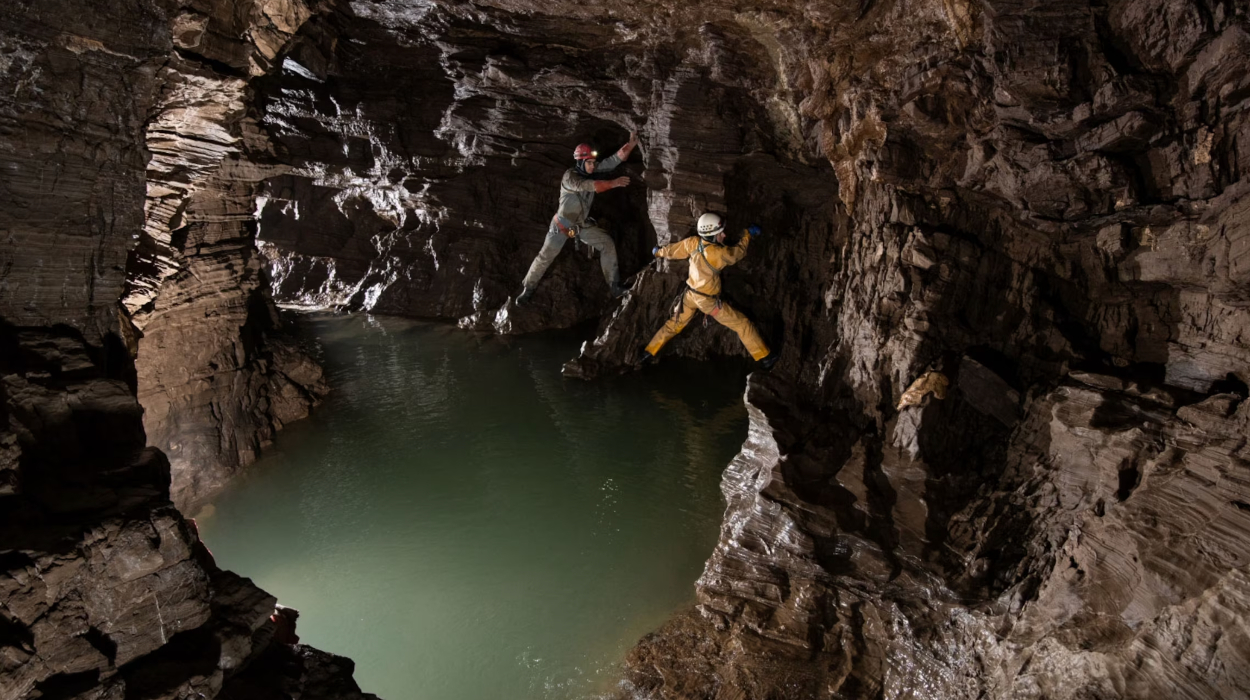Abkhazia's New Caves and the Journey of Naming

Cavers climb around a deep pool of water in one of the Veryovkina cave's side passages. | National Geographic
The small, yet geographically diverse region of Abkhazia has recently gained attention in the speleological community due to new discoveries in its cave systems. Notably, Abkhazia is already recognised for having caves that rank in the first four lines of the world's deepest explored and studied caves, all located in the Arabika Massif. This list includes the Veryovkina Cave, with a depth of 2223 metres, and the Krubera-Voronya Cave, at 2199 metres, Sarma cave at 2199 metres and Snezhnaya cave at at 1340 metres.
The latest exploration efforts by Crimean speleologists have uncovered 15 new caves, both large and small, in areas previously unexplored. This development adds a new chapter to Abkhazia's rich speleological history and prompts a significant cultural discussion regarding the naming of these natural wonders.
Saveliy Chitanava, the Chairman of the State Committee for Ecology of Abkhazia, shared insights into the collaborative efforts and challenges faced in this domain. "We have established a long-standing relationship with Russian speleologists, quite fruitful. They apply to us for a certain period for conducting expeditions. They must receive permission from the State Committee for Ecology of the Republic of Abkhazia in agreement with the Ministry of Tourism. Without this permission, it is forbidden to descend into the caves independently," he explained. This statement highlights the structured and respectful approach to exploring these natural wonders.
Chitanava's said it's beyond mere exploration. "In the course of researching caves in Abkhazia, the question arose of how to name the newly discovered caves, or halls in caves. We have had such a sad experience in previous years - the four deepest caves in the world are located on the territory of Abkhazia, but their names sound in Russian. Well, this is understandable - they were discovered during the Soviet era and were named, as usual, usually in honour of those who discovered them. But now 15 large and small caves have been discovered by Crimean speleologists. But we raised this issue earlier, and so today these speleologists have approached us - how to name them now. They have provisionally named them - Dzharnaz 1, 2, 3, 4, 5... We will hold a joint meeting or working meeting with them to decide. But the names should sound in the Abkhazian language in agreement with the discoverers."
Ten Deepest Caves in the World
| Name | Depth (m) | Length (km) | Country | |
|---|---|---|---|---|
| 1 | Veryovkina Cave | 2223 | 17.5 km (7.2 mi) | Abkhazia |
| 2 | Krubera-Voronja Cave | 2199 | 16.5 km (9.9 mi) | Abkhazia |
| 3 | Sarma cave | 1830 | 19.2 km (11.9 mi) | Abkhazia |
| 4 | Snezhnaja cave | 1760 | 40.8 km (25.4 mi) | Abkhazia |
| 5 | Lamprechtsofen | 1735 | 61 km (38 mi) | Austria |
| 6 | Gouffre Mirolda | 1733 | 13 km (8.1 mi) | France |
| 7 | Gouffre Jean-Bernard | 1625 | 26.6 km (16.5 mi) | France |
| 8 | Sistema del Cerro del Cuevón | 1589 | 7 km (4.3 mi) | Spain |
| 9 | Wot-U-Got Pot | 1560 | 113 km (70 mi) | Austria |
| 10 | Sistema Huautla | 1560 | 89 km (55 mi) | Mexico |
+ Nine new caves have been discovered in Abkhazia
+ Otherworldly Abkhazia cave
+ Duvalius Abyssimus: A New Species Of Beetle In The World's Deepest Cave
Interestingly, these new caves are not in the familiar Arabika Massif but are located in the upper Mchishta region and on the Bzyb mountain range. This discovery not only expands the geographical scope of Abkhazia's caves but also underlines the region's varied and rich geological landscape.
Reflecting on past naming conventions, Chitanava amusingly recounted names from the Soviet era, like "Limpopo" and "Peter the Great's Pants," highlighting the whimsical and sometimes incongruous naming practices of that time.
The revival of speleology in Abkhazia is not just about discovery but also about rekindling a tradition. The Chairman reminisced about the active speleological groups of the Soviet era, led by prominent figures like Zurab Adzinba and Rudolf Bargandzhia. While those groups disbanded over time, there is a renewed effort, led by a new generation of enthusiasts, to establish a robust speleological community in Abkhazia.
The geological diversity of Abkhazia plays a significant role in these discoveries. The abundance of limestone in Western Abkhazia, prone to millennia of leaching and erosion, contrasts with the less prevalent limestone in the eastern regions, creating a unique landscape ripe for speleological exploration.
These developments mark a new era in Abkhazian speleology, blending the thrill of discovery with the pride of cultural identity, as Abkhazia continues to unveil the secrets hidden beneath its rugged terrain.